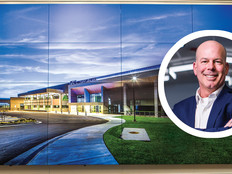Why 2-in-1s Are Taking Off in K–12 Schools
The future of classroom mobility could lie in two-in-ones.
A sales report from Futuresource Consulting projects that the convertible devices — which can serve as either a notebook with a full keyboard or a detachable tablet — will grow to 11 percent of the U.S. education market by the end of this year, more than doubling their school market share from the third quarter of 2015.
The K–12 market trend mirrors the that of the general market: Market research firm Canalys reports that in the first quarter of this year, worldwide PC shipments were weak in all categories except for detachables.
In response to shifting sales, technology makers have stepped up their two-in-one game. HP, Lenovo and Toshiba all unveiled flashy, new devices at the Consumer Electronics Show in Las Vegas in January. But as the top seller of PCs worldwide, Lenovo likely felt particular pressure to build lightweight, versatile devices at affordable prices.
“We're actually combining our PC and our tablet business together right now and looking at, ‘How do we take these different form factors,’” CMO David Roman told Business Insider in January, not long after the company announced the release of its Thinkpad X1 family of convertible devices.
Like HP’s latest Spectre x360 convertible notebook and Toshiba’s dynaPad tablet, Lenovo’s X1 tablet features an optional keyboard, as well as touch-screen capabilities, to give users the portability and productivity benefits they crave.
Increased Flexibility Drives K–12 Adoption
Although notebooks and tablets still represent viable device options for schools and districts, two-in-ones appear especially enticing because of their ability to adapt to students’ needs: The high-resolution displays are ideal for consuming digital resources, while the keyboard attachments allow for content creation.
Two-in-ones could eventually simplify purchasing in schools and districts that currently favor different devices for different grade levels. Schools often supply younger students with hands-on tablets and older students with productivity-focused notebooks.
The Scarborough High School in Maine broke that mold when it selected the flip-design Lenovo Yoga 11e device for its one-to-one program, which launched in 2015. The move was in part driven by teacher input.
“What [teachers are] finding is kids that are coming up from middle school, even your kindergartner, are very comfortable with touch-screen,” Jennifer Lim, Scarborough’s information systems director, told BFN Maine. Teachers wanted a device with touch capabilities.
Robertsville Middle School and Jefferson Middle School in Oak Ridge, Tenn., also found success with the Yoga 11e, and the district has since rolled out the devices in more schools, Oak Ridge Today reports.
“Numerous studies have shown that digital one-to-one initiatives raise student achievement and engagement,” Oak Ridge Schools Superintendent Bruce Borchers told the paper.
It seems likely that two-in-one devices will play a role in improving student outcomes even further.








